알레르기 비염의 증상 징후, Allergic rhinitis symptoms and signs
- 다음 정보를 참조- www.drleepediatrics.com-제15권 소아청소년 알레르기 자가면역 질환-제 1-14 장제1-5장 : 알레르기 비염 (알러지성 비염/알레르기 비염)
- Please visit www.drleepediatrics.com-Volume 15 Pediatric and Adolescent Allergy and Autoimmune Diseases-chapter 제1-5장: Allergic rhinitis
알레르기 비염의 증상증후를 구체적으로 더 설명하면
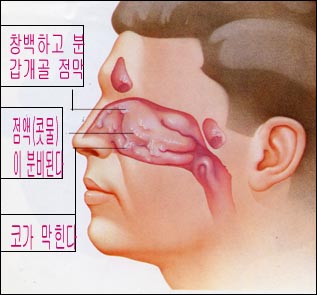
그림 92. 알레르기 비염의 대표적 증상
Used with permission from Schering Corporation Kenilworth, NJ 07033과 소아가정간호백과
- 알레르기 비염의 증상 징후는 다양하다.
- 또 나이, 항원의 종류, 합병증의 유무 등에 따라 다르다.
- 알레르기 비염의 전형적인 증상과 징후에 관해 위에서 p.00에서 이미 설명했지만 다시 여기서 구체적으로 더 설명한다.
- 콧물이 나고
- 코가 막히고 가렵고
- 재채기 하고
- 눈이 붉고 가렵고 눈물이 날 수 있다.
- 데니스 주름살(Dennie’s line)이 콧등에 생길 수 있다.
- 때로는 입천장이 가려울 수 있고
- 이런 증상과 징후가 계절적 알레르기 비염이 계절에 따라 재발이 될 때마다 생길 수 있고
- 또는 1년 내내 생길 수 있는 통년성 알레르기 비염과 계절적 알레르기 비염이 같이 생길 수 있다.
- 이런 증상이나 징후의 정도는 경도, 중등도, 또는 중증도로 나타날 수 있다.
- 알레르기 비염의 증상과 징후는 신생아기부터 시작할 수 있고 그 후 어느 연령에서도 시작될 수 있다.
- 특히 아토피 체질을 가진 신생아가 우유 단백질이나 콩 단백질이 든 인공영양을 먹기 시작하면 알레르기 비염이나 다른 종류의 알레르기 질환이 생기기 시작할 수 있고 그로 인해 각종 알레르기 비염의 증상 징후가 생길 수 있다.
- 아토피 체질이 있는 신생아들이나 신생아기 이후 영유아들이 우유 단백질이 든 인공영양, 우유, 또는 우유가 든 음식물을 계속 먹으면 그들에게 우유 단백질로 유발되는 알레르기 비염이 생길 수 있다. 그 후 그런 음식물을 계속 섭취하면 그런 증상 징후가 점점 더 심하게 나타날 수 있다.
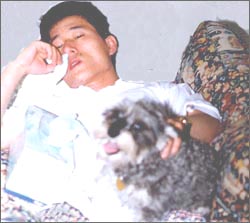
사진 93. 알레르기 비염이 있으면 콧물이 자주 나고 코가 자주 막힌다.
Copyright ⓒ 2011 John Sangwon Lee, MD., FAAP
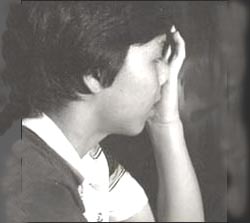
사진 94. 코를 자주 문지른다.
사진에서 보는 것과 같이 경례하는 자세로 코를 문지른다고 해서 “알레르기 설루트”란 말을 쓴다. Copyright ⓒ 2011 John Sangwon Lee, MD., FAAP
- 우유 단백질이 든 음식물에 알레르기 비염이 있는 아이들이 집 먼지 진드기(집 먼지 좀 진드기) 항원에 노출될 때 집 먼지 진드기(집 먼지 좀 진드기)로 알레르기 비염이 유발될 가능성이 더 많다. 또 우유 단백질로 알레르기 비염과 집 먼지 진드기(집 먼지 좀 진드기)로 알레르기 비염이 동시에 유발될 수 있다.
- 신생아들이나 영아들에게 알레르기 비염이 생기면 코가 자주 막히고 입을 벌리고 입을 통해 숨을 쉴 때가 많다.
- 이런 증상을 게이핑(Gaping),경구호흡 또는 구강호흡이라 한다(사진 95, 96, 97, 98 참조).
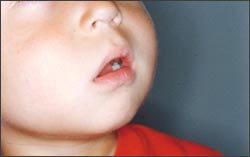
사진 95. 알레르기 비염으로 코가 막히면 입을 벌리고 입으로 숨 쉰다. 이런 호흡을 “구강호흡” 또는 “게이핑(Gaping)”이라도 한다.
Copyright ⓒ 2011 John Sangwon Lee, MD., FAAP

사진 96. 알레르기 비염 으로 코가 막히면 입을 벌리고 입을 통해 숨 쉰다. 이런 호흡을 구강호흡 또는 게이핑이라 한다.
Copyright ⓒ 2011 John Sangwon Lee, MD., FAAP
- 알레르기 비염이 적절히 잘 치료되지 않으면 이런 경구호흡 증상 징후가 신생아기 때부터 사춘기가 될 때까지 계속될 수 있고 성인이 된 이후에도 계속 나타날 수 있다.
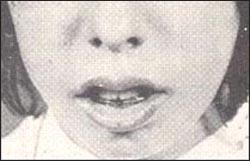
사진 97. 알레르기 비염으로 코가 막히면 입을 벌리고 숨을 쉴 수 있다
출처:Used with permission from Annals of Allergy와 소아가정간호백과
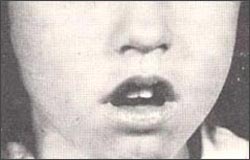
사진 98. 알레르기 비염으로 코가 막히면 입을 벌리고 숨 쉰다
출처:Used with permission from Annals of Allergy와 소아가정간호백과
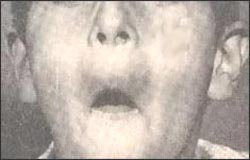
사진 99. 알레르기 비염의 증상으로 얼굴을 실룩거릴 수 있다.
Used with permission from Annals of Allergy와 소아가정간호백과

사진 100. 알레르기 비염으로 얼굴을 실룩거릴 수 있다.
Used with permission from Annals of Allergy와 소아가정간호백과
- 알레르기 비염으로 입을 벌리고 숨 쉬는 증상과 징후가 생기고 그 외 뻐드렁니, 옥니, 부정교합 등 치열 이상이 생길 수 있고(사진 101, 102, 103, 104, 106) 눈, 코, 입, 얼굴, 잇몸 등의 해부학 구조의 상호 관계에 이상이 생길 수 있다.
- 알레르기 비염이 오랫동안 지속될 때 특이한 얼굴형이 생긴다. 이런 특이한 얼굴형(안모)를 ‘아데노이드 안모’라고 한다. 요즘 알레르기 비염이 잘 치료되기 때문에 이러한 안모를 보기 힘들다.
- 영유아들에게 심한 알레르기 비염의 증상 징후는 감기를 앓을 때 생기는 증상 징후와 비슷한 점이 많이 있다.
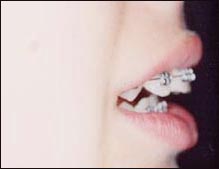
사진 101. 부정교합이 알레르기 비염으로 생길 수 있다. 심한 부정교합은 치열 보정기 치료와 알레르기 비염 을 치료해서 치료한다.
Copyright ⓒ 2011 John Sangwon Lee, MD., FAAP
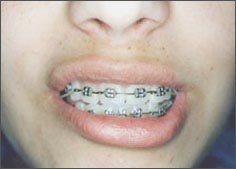
사진 102. 부정교합이 알레르기 비염으로 생길 수 있다. 심한 부정교합은 치열 보정기 치료와 알레르기 비염을 적절히 치료하면 더 효과적으로 치료된다.
Copyright ⓒ 2011 John Sangwon Lee, MD., FAAP
- 비강 점막층이 붓고 충혈되고 코가 막히고 콧물이 나고 재채기를 자주 많이 할 수 있다.
- 코가 자주 막히면 코로 숨을 잘 쉴 수 없기 때문에 입을 벌리고 입으로 숨을 주로 쉴 때가 많다.
- 비강 기도 부분과 상기도 기도 부분의 일부가 막혀 폐쇄성 무호흡증(차단성 무호흡증)이 생길 수 있다. 그리고 잠도 잘 자지 못한다.
- 감기를 앓을 때는 미열 내지 고열이 날 수 있고 인두가 아프고 몸이 아픈 것이 보통이며 증상은 1~2주 정도 지나면 없어지는 것이 보통이다.
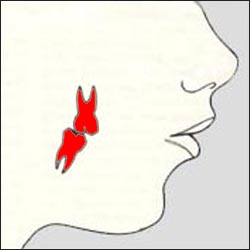
그림 103. 만성 알레르기비염이 있으면 상악 치열과 하악 치열이 서로 맞지 않는 부정교합이 생길 수 있다.
Used with permission from Annals of Allergy와 소아가정간호백과
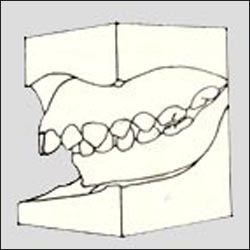
그림 104. 상악 치열과 하악 치열이 서로 맞지 않는 부정교합이 생길 수 있다.
Used with permission from Annals of Allergy와 소아가정간호백과
- 알레르기 비염만 앓을 때는 열이 나지 않고 인두통도 없고 몸이 아픈 증상도 없고 1주 이상 계속 된다. 이렇게 감기와 알레르기 비염은 다르나 때로는 이 두 병을 함께 앓을 때도 있다.
- 학령기 아이들에게 알레르기 비염이 있으면 코가 자주 막힐 수 있고 비강의 후부에 있는 아데노이드와 입안 양쪽에 있는 두 편도가 비정상적으로 많이 커질 수 있다.
- 알레기성 비염이 만성으로 이어지면 코가 유난히 더 커질 수 있다. 이렇게 알레르기 비염으로 커진 코를 ‘양키코’라는 별명도 붙인다(그림 참조).
- 알레르기 비염, 특히 만성 알레르기 비염이 있는 아이들의 아데노이드의 크기는 비정상적으로 현저히 더 크고 편도도 비정상적으로 더 큰 것이 보통이다.
- 이런 이유로, 말할 때 코 먹은 소리로 말을 할 수 있고 잘 때 코를 고는 경우가 많다.
- 자는 동안이나 깨어 있는 동안 콧구멍을 자주 후비고 코를 자주 문지르는 버릇이 있다.
- 알레르기 비염이 있으면 비강 점막층이 붓고 창백하고 습하고 점막층 모세혈관이 확장되어 있다.
- 자칫하면 확장된 모세혈관이 터져 코피도 자주 날 수 있다. [부모도 반의사가 되어야한다-소아가정간호백과]-제 1권 소아청소년 응급의료-비출혈, 제 18권 소아청소년 이비인후 질환-비출혈 참조
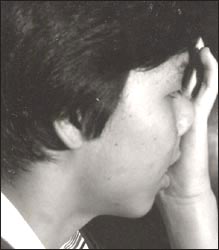
사진 105. 알레르기 비염이 있는 아이들은 경례하는 손 자세와 같이 손으로 코를 위로 밀어 올리면서 문지른다. 이런 이유로, 코의 경골과 연골이 연결되는 부위에 있는 콧등의 피부에 횡으로 주름살이 잡힐 수 있다. 이런 징후를 데니스 주름살(Dennie’s lines)이라 한다.
Copyright ⓒ 2011 John Sangwon Lee, MD., FAAP
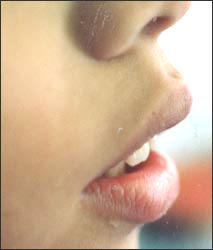
사진 106. 알레르기 비염으로 코가 막히면 입을 벌리고 입으로 숨 쉰다. 이런 증상을 게이핑(구강호흡)이라 한다.
Copyright ⓒ 2011 John Sangwon Lee, MD., FAAP

사진 108. 알레르기 비염으로 아래 눈꺼풀 피부색이 거무스름하다. 이런 증상을 알레르기 샤이너라고 한다. 위 사진에서 볼 수 있는 것 같이 아래 눈꺼풀에 주름살이 잡힐 수 있다.데니-몰간 주름살(Dennie–Morgan line)이라고 한다.
Copyright ⓒ 2011 John Sangwon Lee, MD., FAAP
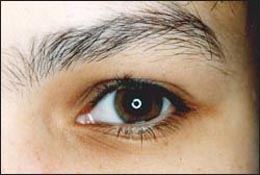
사진 107. 알레르기 비염으로 아래 눈꺼풀과 바로 그 아래 피부색이 거무스름하게 된다. 이런 증상을 “알레르기 샤이너”라고 한다. 아래 눈꺼풀의 아래에 주름살이 잡힐 수 있다.데니-몰간 주름살(Dennie–Morgan line)이라고 한다.
Copyright ⓒ 2011 John Sangwon Lee, MD., FAAP
- 밤에 누워 잘 때 콧물이 비강 후부로 흘러가서 그로 인해 인두 강이 자극돼서 자다가 기침을 간간히 할 수 있다. 또 알레르기 비염이 있는 아이들의 대부분(80~90%)은 천식을 동시 앓고 있기 때문에 때로는 알레르기 비염과 천식이 두 병으로 인해 기침을 할 수 있다.
- 천식이 있는 아이들의 대부분은 잠자는 동안 야간성 천식이 발작돼서 자다가 기침을 하는 것이 보통이다. 이런 기침을 여러 날 동안 할 수도 있다. 이렇게 잘 때 발작되는 천식을 야간성 천식이라고 한다.
- 알레르기 비염이 있는 아이들이 밤에 자다가 기침을 할 때 야간성 천식이 유발돼서 기침을 하는지, 알레르기 비염으로 기침을 하는지, 또는 알레르기 비염과 야간성 천식 발작 이 두 병으로 인해서 기침을 하는지 감별 진단하기가 어려울 때도 있다.
- 이 두 가지 병을 동시 치료해주면 기침을 더 이상 하지 않는 것이 보통이다.[부모도 반의사가 되어야한다-소아가정간호백과]-제 1권 소아청소년 응급의료. 제 18권 소아청소년 이비인후 질환-코피가 날 때
- 전두동, 접형동, 사골동 등 여러 개의 부비동이 정상적으로 비강 주위에 있다. 비강 속과 그 주위에 있는 부비동 속은 작은 자연 통로로 서로 연결되어 있다. 그 통로의 점막층이 알레르기 비염으로 부어 쉽게 막힐 수 있다. 그로 인해 부비동염 (축농증)이 흔히 생길 수 있다.
- 이런 이유로 알레르기 비염이 있는 아이들의 대부분은 부비동염에 더 잘 걸린다(그림 109 참조).
- 알레르기 비염으로도 자주 두통을 호소할 수 있다.
- 알레르기 비염과 부비동염이 함께 있을 때 부비동 속과 비강 속 사이를 연결하는 자연 통로가 막힐 수 있다. 자연 통로가 막힐 때 두통이 생길 수 있다. 이런 두통을 사이누스 두통(Sinus headache)이라 한다.

그림 109. 알레르기 비염이 있으면 부비동염에 더 잘 걸릴 수 있다. 박테리아 부비동염에 걸리면 그림에서 보는 것 같이 고름 섞인 누런 콧물이 날 수 있다.
a-고름이 잡힌 전두동 염, b-충혈이 된 비갑개, c-고름이 섞인 콧물이 날 수 있다.
Used with permission from Schering corporation, NJ, USA와 소아가장간호 백과
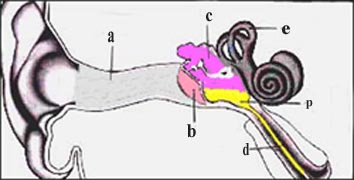
그림 110. 알레르기 비염이 있으면 중이염에 더 잘 걸릴 수 있다
a-외이도, b-고막, c-중이 강, d-구씨관(이관), e-내이, p-중이 강 내 고름
Copyright ⓒ 2011 John Sangwon Lee, MD.,FAAP
- 합병증이 없이 알레르기 비염만 있을 때는 맑은 점액성 콧물이 주로 나오는 것이 보통이다. 그러나 알레르기 비염과 박테리아 부비동염이 동시 있을 때는 누렇고 퍼렇고 짙은 콧물이 나올 수 있다.
- 알레르기 비염만 있든지, 부비동염만 있든지, 또는 두 가지 병이 동시에 있을 때도 맑은 콧물이 조금 나올 수 있고, 콧물이 나지 않고 그냥 코가 막히는 증상만 있을 수 있다.
- 알레르기 비염이 있는 아이들의 이관(유스타키오관/구씨관/Eustachian tube)이 부어 자주 막힐 수 있고, 급성 중이염, 또는 삼출성 중이염에 자주 걸릴 수 있다. [부모도 반의사가 되어야한다-소아가정간호백과]-제 18권 소아청소년 이비인후 질환-재발성 중이염, 급성 부비동염 참조
- 알레르기 비염이 있는 아이들의 눈, 부비동, 아데노이드, 편도, 인두 강, 구강 등에 알레르기 질환에 관련된 증상 징후가 잘 생길 수 있다.
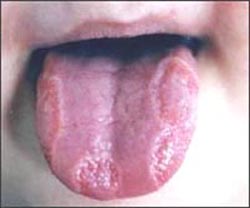
사진 111. 알레르기 비염이 있는 아이들에게 지도형 혀가 자주 생길 수 있다.
Copyright ⓒ 2011 John Sangwon Lee, MD., FAAP
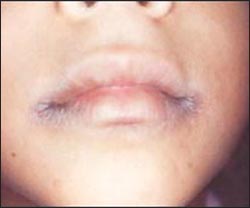
사진 112. 알레르기 비염이 있는 아이들에게 구순염과 입 주위 피부염이 자주 생길 수 있다.
Copyright ⓒ 2011 John Sangwon Lee, MD., FAAP
- 예를 들면, 알레르기 비염이 있는 아이들의 대부분에게 알레르기성 결막염이 동시 생길 수 있다. 그래서 결막이 자주 충혈되고 눈이 빨갛고 눈물이 자주 나고 눈이 가려워 눈을 자주 비빌 수 있다. [부모도 반의사가 되어야한다-소아가정간호백과]-제 18권 소아청소년 이비인후 질환-알레르기성 결막염 참조
- 아토피 체질이 있는 아이들의 아데노이드는 아토피 체질이 아닌 아이들의 아데노이드의 크기보다 훨씬 더 크고 비대되어 있는 것이 보통이다. [부모도 반의사가 되어야한다-소아가정간호백과]-제 18권 소아청소년 이비인후 질환-편도선 절제 수술, 아데노이드와 아데노이드 비대 참조.
- 또 마찬가지로 편도도 현저히 커져 있는 것이 보통이다(사진 114 참조). 그 때문에 알레르기 비염이 있는 아이들의 일부는 수면 중 기도가 일부 잠시 막혀 괴롭게 숨 쉬거나 코를 골 수 있다.
- 그래서 폐쇄수면 무호흡증이 생겨 자다가 숨 넘어 가듯이 괴로워하고 깰 수 있다.
- 아래턱 바로 밑 목 부위에 있는 림프절들이 비대되어 있는 것이 보통이다.
- 눈과 코뿐만 아니라 인두와 입천장이 가려울 수 있다.
- 알레르기 비염을 가진 아이들이 밤에 자다가 인두, 입천장 등이 가려울 때 손으로 가려움을 제거하는 대신 위턱과 아래턱을 놀리어 가려움을 경감시키려한다. 가려움을 경감 시키는 방법의 하나로 무의식적으로 이를 가는 현상이 나타난다.
- 그 때문에 알레르기 비염이 있는 아이들의 대부분은 밤에 자다가 이를 자주 가는 버릇이 생긴다. [부모도 반의사가 되어야한다-소아가정간호백과]-제 20권 소아청소년 구강 치아 질병-이를 가는 버릇 참조
- 비염이 있는 아이들은 코가 자주 막혀 입을 벌리고 숨을 쉰다. 때문에 구강, 얼굴, 코, 치아, 잇몸 등의 해부학적 상호 관계가 많이 변화된다. (그림 3, 104 참조).
- 그 결과로 부정교합이나 아데노이드 안모 등이 생길 수 있다. 그리고 그 외 여러 가지의 변화가 얼굴에 생길 수 있다. [부모도 반의사가 되어야한다-소아가정간호백과]-제 20권 소아청소년 구강 치아 질병-부정교합 참조
- 알레르기 비염이 있는 아이들이 감기에 걸리거나 다른 종류의 바이러스성 상기도 염에 걸리면 알레르기 비염의 증상 징후가 훨씬 더 악화될 수 있다. 그래서 상기도염의 증상 징후가 훨씬 더 심하게 나타날 수 있다.
- 알레르기 비염이 있는 아이들에게 천식, 부비동염, 중이염, 습진, 음식물 알레르기 질환, 약물 알레르기, 곤충 알레르기 등이 더 잘 생긴다.
- 코가 가려워서 코를 밀어 올리면서 코를 문지르는 버릇으로 코 경골과 코 연골이 연결 되는 부위 콧등에 피부 주름살이 가로로 잡힐 수 있다. 이러한 징후는 데니스 주름살이라고 한다. 손으로 코를 밀어 올려 코를 문지르는 징후를 ‘알레르기성 경례’ 또는 ‘알레르기성 설루트’ 라고 한다(그림 94, 105 참조).
- 두 눈 아래 눈꺼풀의 바로 밑에 있는 피부색이 거무스름하게 변할 수 있다. 타박상을 입은 2~3일 후에 거무스름하게 생긴 피부색과 거의 같다고 해서 ‘알레르기성 샤이너’라고 부른다. 알레르기성 샤이너는 일시적으로 생길 수도 있고 한 번 생긴 후 몇 개월 동안 또는 그 이상 더 오랫동안 계속 될 수도 있다.
- 다시 설명하면, 샤이너란 말은 얼굴이나 신체 어떤 부위가 타박상을 입었을 때 타박상을 입은 후 피부색이 거무스름하게 일시적으로 변화된 상태를 의미한다(사진 107, 108 참조).
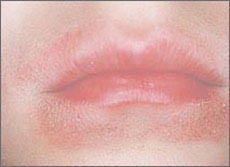
사진 113. 알레르기 비염이 있는 아이들의 입술 가장자리에 습진과 비슷한 피부염이 생길 수 있다. [부모도 반의사가 되어야 한다-소아가정간호백과]-제 17권 소아청소년 피부질환 참조.
Copyright ⓒ 2011 John Sangwon Lee, MD.,FAAP
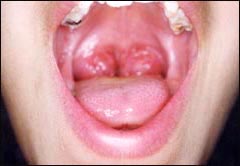
사진 114. 알레르기 비염이 있는 아이들의 편도와 아데노이드는 비정상적으로 많이 커져 있을 수 있다.
Copyright ⓒ 2011 John Sangwon Lee, MD., FAAP
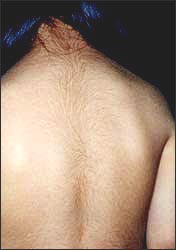
사진 115. 알레르기 비염이 있는 아이들에게 체모가 더 많이 나는 것이 보통이다. [부모도 반의사가 되어야 한다-소아가정간호백과]-제 17권 소아청소년 피부질환 참조.
Copyright ⓒ 2011 John Sangwon Lee, MD., FAAP

사진 116. 알레르기 비염이 있는 아이들의 체모는 더 많이 나는 것이 보통이다. [부모도 반의사가 되어야 한다-소아가정간호백과]-제 17권 소아청소년 피부질환 참조.
Copyright ⓒ 2011 John Sangwon Lee, MD., FAAP
- 위에서 이미 설명했지만 알레르기 비염이 오랫동안 계속 될 때 코, 비강 속, 입 속, 아데노이드, 편도선 등의 해부학적 상호 구조 관계가 특이하게 변화 된다.
-
그래서 심한 알레르기 비염이 오랫동안 있는 아이들의 얼굴에 이런 여러 가지 증상과 징후들이 생기고 그들의 얼굴 모양이 마치 바보 얼굴 모양으로 변할 수 있다. 이런 얼굴 모양을 아데노이드 얼굴형, 또는 아데노이드 안모라고 한다(그림 75 참조).[부모도 반의사가 되어야 한다-소아가정간호백과]-제 18권 소아청소년 이비인후 질환-아데노이드 비대 참조.
Allergic rhinitis symptoms and signs
• See the following information – www.drleepediatrics.com – Volume 15 Children and Adolescent Allergic Autoimmune Diseases – Chapters 1-14 Chapters 1-5: Allergic Rhinitis (Allergic Rhinitis/Allergic Rhinitis)
• Please visit www.drleepediatrics.com-Volume 15 Pediatric and Adolescent Allergy and Autoimmune Diseases-chapter Chapters 1-5: Allergic rhinitis Describe the symptoms of allergic rhinitis in more detail.

Figure 92. Representative symptoms of allergic rhinitis Used with permission from Schering Corporation Kenilworth, NJ 07033 and Encyclopedia of Pediatric and Family Nursing
• Symptoms and signs of allergic rhinitis vary.
• It also depends on the age, the type of antigen, and the presence or absence of complications.
• The typical symptoms and signs of allergic rhinitis have already been described above on but are further detailed here again.
• runny nose
• Stuffy and itchy nose
• sneezing
• Your eyes may be red, itchy, and watery.
• Dennie’s line can form on the bridge of the nose.
• Sometimes the roof of the mouth may itch and
• These symptoms and signs may occur whenever seasonal allergic rhinitis recurs from season to season.
• Or year-round allergic rhinitis and seasonal allergic rhinitis can occur together.
• The severity of these symptoms or signs may be mild, moderate, or severe.
• Symptoms and signs of allergic rhinitis can begin in newborns and at any age thereafter.
• In particular, when newborns with atopic constitution start eating artificial nutrition containing milk protein or soy protein, allergic rhinitis or other allergic diseases may begin to develop, which may cause various symptoms of allergic rhinitis.
• Newborns with atopic constitution or infants and young children after the neonatal period may develop milk protein-induced allergic rhinitis if they continue to consume artificial nutrition containing milk protein, milk, or food containing milk. After that, if you continue to eat those foods, the symptoms can become more and more severe.

Photo 93. If you have allergic rhinitis, you have a runny nose and a stuffy nose. Copyright ⓒ 2011 John Sangwon Lee, MD., FAAP

Photo 94. Frequent rubbing of the nose. As you can see in the photo, rubbing your nose in a saluting position is why you use the term “allergy solution”. Copyright ⓒ 2011 John Sangwon Lee, MD., FAAP
• Children with allergic rhinitis to foods containing milk protein are more likely to develop allergic rhinitis with house dust mite (house dust mite) when exposed to the house dust mite (house dust mite) antigen. Also, milk protein can cause allergic rhinitis and house dust mites (house dust mites) can cause allergic rhinitis at the same time.
• Newborns and infants with allergic rhinitis often have a stuffy nose and often breathe through their mouths with their mouths open.
• This symptom is called gaping, oral breathing or oral breathing (see pictures 95, 96, 97, 98).

Photo 95. If your nose is stuffy with allergic rhinitis, open your mouth and breathe through your mouth. This breathing is also called “mouth breathing” or “gaping”. Copyright ⓒ 2011 John Sangwon Lee, MD., FAAP

Photo 96. If your nose is stuffy with allergic rhinitis, open your mouth and breathe through your mouth. This breathing is called mouth breathing or gapping. Copyright ⓒ 2011 John Sangwon Lee, MD., FAAP
• If allergic rhinitis is not treated adequately, these signs of oral respiratory symptoms may continue from infancy through puberty and may continue into adulthood.

Photo 97. If your nose is blocked due to allergic rhinitis, you can breathe with your mouth open. Source: Used with permission from Annals of Allergy and Encyclopedia of Pediatric and Family Nursing
 Photo 98. Open your mouth and breathe when your nose is stuffy with allergic rhinitis Source: Used with permission from Annals of Allergy and Encyclopedia of Pediatric and Family Nursing
Photo 98. Open your mouth and breathe when your nose is stuffy with allergic rhinitis Source: Used with permission from Annals of Allergy and Encyclopedia of Pediatric and Family Nursing

Photo 99. A symptom of allergic rhinitis can cause a flabby face. Used with permission from Annals of Allergy and Encyclopedia of Pediatric and Family Nursing

Picture 100. Allergic rhinitis can make your face twitch. Used with permission from Annals of Allergy and Encyclopedia of Pediatric and Family Nursing
• Allergic rhinitis can cause symptoms and signs of breathing with the mouth open, and other dental abnormalities such as crooked teeth, jagged teeth, and malocclusion (Pictures 101, 102, 103, 104, 106). Eyes, nose, mouth, face, gums, etc. There may be abnormalities in the interrelationships of the anatomy of
• When allergic rhinitis persists for a long time, a peculiar face shape occurs. This unusual face shape (face) is called ‘adenoid face’. These days, it is difficult to see such a face because allergic rhinitis is being treated well.
• Symptoms of severe allergic rhinitis in infants and young children have many similarities to those of a cold.

Picture 101. Malocclusion can be caused by allergic rhinitis. Severe malocclusion is treated with orthodontic treatment and allergic rhinitis. Copyright ⓒ 2011 John Sangwon Lee, MD., FAAP

Picture 102. Malocclusion can be caused by allergic rhinitis. Severe malocclusion can be treated more effectively with orthodontic treatment and proper treatment of allergic rhinitis. Copyright ⓒ 2011 John Sangwon Lee, MD., FAAP
• The nasal mucosa may be swollen and red, with a stuffy nose, runny nose and frequent sneezing.
• If your nose is often blocked, you may not be able to breathe through your nose, so you often breathe through your mouth with your mouth open.
• Obstructive apnea (obstructive apnea) can occur due to blockage of portions of the nasal airways and portions of the upper airways. And I can’t even sleep well.
• When you have a cold, you may have low to high fever, sore throat, and body aches. The symptoms usually disappear after 1 to 2 weeks.

Figure 103. In chronic allergic rhinitis, malocclusion between the maxillary and mandibular dentition may occur. Used with permission from Annals of Allergy and Encyclopedia of Pediatric and Family Nursing

Figure 104. A malocclusion may occur where the maxillary and mandibular dentitions do not match. Used with permission from Annals of Allergy and Encyclopedia of Pediatric and Family Nursing
• When you suffer from allergic rhinitis alone, there is no fever, no sore throat, no symptoms, and it lasts for more than a week. Although cold and allergic rhinitis are different, sometimes these two diseases can be combined.
• Allergic rhinitis in school-age children can cause frequent nasal congestion and abnormal enlargement of the adenoids at the back of the nasal passages and the two tonsils on either side of the mouth.
• If allergic rhinitis becomes chronic, the nose may become unusually large. A nose that has grown from allergic rhinitis is also nicknamed ‘Yankee’s nose’ (see picture).
• In children with allergic rhinitis, particularly chronic allergic rhinitis, it is common for adenoids to be abnormally markedly larger and the tonsils to be abnormally large.
• For this reason, you can snort when speaking, and you often snore when you sleep.
• You have a habit of frequently picking your nostrils and rubbing your nose while sleeping or awake.
• In allergic rhinitis, the nasal mucosa is swollen and pale and moist, and the capillaries of the mucosal layer are dilated.
• If you don’t, the dilated capillaries may burst and you may have frequent nosebleeds. [Parents should also become at least the half-doctors-Pediatric and Family Nursing Encyclopedia]-Vol. 1 Pediatric emergency medical care-Non-bleeding, Vol. 18 Pediatric Otolaryngology Disease-Nonbleeding

Photo 105. Children with allergic rhinitis rub their noses upwards with their hands in a saluting hand pose. For this reason, the skin on the bridge of the nose in the area where the tibia and cartilage of the nose connect may be wrinkled horizontally. These signs are called Dennie’s lines. Copyright ⓒ 2011 John Sangwon Lee, MD., FAAP

Photo 106. Open your mouth and breathe through your mouth if your nose is stuffy with allergic rhinitis. This symptom is called gaping (mouth breathing). Copyright ⓒ 2011 John Sangwon Lee, MD., FAAP

Picture 108. The skin color of the lower eyelid is dark due to allergic rhinitis. These symptoms are called allergy shiners. As you can see in the photo above, wrinkles may appear on the lower eyelids. This is called the Dennie-Morgan line. Copyright ⓒ 2011 John Sangwon Lee, MD., FAAP

Picture 107. Allergic rhinitis causes darkening of the lower eyelid and the skin just below it. These symptoms are called “allergy shiners.” Wrinkles may form under the lower eyelids, called the Dennie–Morgan line. Copyright ⓒ 2011 John Sangwon Lee, MD., FAAP
• When you lie down at night, runny nose runs down the back of your nasal passages, which irritates your pharyngeal cavity, which can cause you to cough intermittently while sleeping. In addition, since most (80-90%) of children with allergic rhinitis suffer from asthma at the same time, sometimes both allergic rhinitis and asthma can cause coughing.
• Most children with asthma have nocturnal asthma attacks while sleeping, and coughing while sleeping is common. This cough can last several days. Asthma that occurs during sleep is called nocturnal asthma.
• Differentially diagnose whether children with allergic rhinitis cough at night when they cough at night because of nocturnal asthma, allergic rhinitis, or both allergic rhinitis and nocturnal asthma attack Sometimes it is difficult to
• If these two diseases are treated at the same time, it is common to not cough anymore. Book 18 Children and Adolescents with Otolaryngeal Diseases-When nosebleeds occur
• Several sinuses, such as the frontal, sphenoid, and ethmoid sinuses, are normally located around the nasal cavity. The nasal cavity and the sinuses surrounding it are interconnected by small natural passages. The mucosal layer of the passage can be easily blocked by swelling with allergic rhinitis. This can often lead to sinusitis (sinusitis).
• For this reason, most children with allergic rhinitis are more prone to sinusitis (see Figure 109).
• Allergic rhinitis can cause frequent headaches.
• When allergic rhinitis and sinusitis coexist, the natural passage between the sinuses and the nasal passages can be blocked. Headaches can occur when natural pathways are blocked. Such a headache is called a sinus headache.

Figure 109. If you have allergic rhinitis, you may be more prone to sinusitis. If you get bacterial sinusitis, you may have a runny nose mixed with pus as shown in the picture. A – frontal sinusitis with pus, b – congested turbinate, c – runny nose mixed with pus. Used with permission from Schering corporation, NJ, USA and Encyclopedia of Pediatric Parenting Nursing

Figure 110. People with allergic rhinitis may be more prone to otitis media a-external auditory canal, b-tympanic membrane, c-middle ear cavity, d-bulbar canal (ear tube), e-inner ear, p-pus in middle ear cavity Copyright ⓒ 2011 John Sangwon Lee, MD., FAAP
• When there is only allergic rhinitis without complications, it is normal to have a clear, mucous runny nose. However, when allergic rhinitis and bacterial sinusitis occur at the same time, a yellow, blue, and thick runny nose may come out.
• Even when there is only allergic rhinitis, sinusitis, or both diseases at the same time, a small amount of clear runny nose may come out, and there may be no runny nose, just a stuffy nose.
• Children with allergic rhinitis may often have swollen and blocked ear tubes (Eustachian tube/Bulb/Eustachian tube), and often have acute otitis media or otitis media with effusion. [Parents should also become anti-doctors – Encyclopedia of Pediatric and Family Nursing] – Volume 18 Children and Adolescent Otolaryngology – See Recurrent Otitis Media, Acute Sinusitis
• Children with allergic rhinitis may develop symptoms related to allergic diseases in the eyes, sinuses, adenoids, tonsils, pharyngeal cavity, and mouth.

Picture 111. Children with allergic rhinitis can often develop a superficial tongue. Copyright ⓒ 2011 John Sangwon Lee, MD., FAAP

Photo 112. Children with allergic rhinitis can frequently develop cheilitis and dermatitis around the mouth. Copyright ⓒ 2011 John Sangwon Lee, MD., FAAP
• For example, most children with allergic rhinitis can co-exist with allergic conjunctivitis. Therefore, the conjunctiva is often red, the eyes are red and watery, and the eyes are itchy, which can cause frequent rubbing.
[Parents should also become at least the half-doctors – Encyclopedia of Pediatric and Family Nursing] – Volume 18 Children’s and Adolescent Otolaryngology – Refer to Allergic Conjunctivitis• It is common for adenoids in children with atopic constitution to be much larger and enlarged than the adenoids in children without atopic constitution. [Parents should also become anti-doctors – Encyclopedia of Pediatric and Family Nursing] – Volume 18 Children and Adolescent Otolaryngology – Tonsillectomy, see Adenoids and Adenoid Enlargement.
• Likewise, the tonsils are usually markedly enlarged (see photo 114). As a result, some children with allergic rhinitis may temporarily block their airways during sleep, making it difficult to breathe or snore.
• As a result, you may develop obstructive sleep apnea and wake up in distress as if you were out of breath.
• It is common for lymph nodes in the neck area just below the lower jaw to be enlarged.
• The pharynx and roof of the mouth, as well as the eyes and nose, may itch.
• Children with allergic rhinitis try to relieve itching by playing with the upper and lower jaws instead of removing the itch by hand when the pharynx or roof of the mouth is itchy at night. One of the ways to relieve itching is to unconsciously grind your teeth.
• Because of this, most children with allergic rhinitis develop a habit of frequently brushing their teeth at night. [Parents should also become at least the half-doctors – Encyclopedia of Pediatric and Family Nursing] – Volume 20 Children’s and Adolescents Oral and Dental Diseases – See Grinding Habits
• Children with rhinitis often have a stuffy nose and breathe with their mouths open. Because of this, the anatomical interrelationships of the oral cavity, face, nose, teeth, and gums change a lot. (See Fig. 3, 104).
• As a result, malocclusion or adenoid facial hair may occur. And many other changes can occur on the face. [Parents should also become at least -doctors – Encyclopedia of Pediatric and Family Nursing] – Refer to Volume 20 Oral and Dental Diseases – Malocclusion
• When children with allergic rhinitis catch a cold or some other type of viral upper respiratory tract infection, the symptoms of allergic rhinitis can get even worse. So the symptoms of upper respiratory tract infection can be much more severe.
• Children with allergic rhinitis are more prone to asthma, sinusitis, otitis media, eczema, food allergy, drug allergy, and insect allergy.
• If you have an itchy nose and rub your nose while pushing up your nose, wrinkles may form on the bridge of the nose where the tibia and cartilage of the nose connect. These signs are called Dennis wrinkles. The indication of rubbing the nose by pushing up the nose with the hand is called ‘allergic salute’ or ‘allergic salute’ (see Figures 94 and 105).
• The skin color just under the eyelids under both eyes may turn dark. It is called ‘allergic shiner’ because it is almost identical to the dark skin color that appears after two or three days of bruising. Allergic shiners can be temporary or can persist for several months or longer.
• In other words, the term “shiner” refers to a condition in which the skin color temporarily changes to darken after a bruise when the face or any part of the body is bruised (refer to photos 107 and 108).

Picture 113. Children with allergic rhinitis may develop eczema-like dermatitis on the edge of the lips. [Parents should also become anti-doctors – Encyclopedia of Pediatric and Family Nursing] – Refer to Vol. 17 Skin Diseases in Children and Adolescents. Copyright ⓒ 2011 John Sangwon Lee, MD., FAAP

Picture 114. The tonsils and adenoids in children with allergic rhinitis may be abnormally large. Copyright ⓒ 2011 John Sangwon Lee, MD., FAAP

Photo 115. It is normal for children with allergic rhinitis to have more body hair. [Parents should also become at least the half-doctors – Encyclopedia of Pediatric and Family Nursing] – Refer to Vol. 17 Skin Diseases in Children and Adolescents. Copyright ⓒ 2011 John Sangwon Lee, MD., FAAP

Photo 116. It is normal for children with allergic rhinitis to have more body hair. [Parents should also become anti-doctors – Encyclopedia of Pediatric and Family Nursing] – Refer to Vol. 17 Skin Diseases in Children and Adolescents. Copyright ⓒ 2011 John Sangwon Lee, MD., FAAP
• As already explained above, when allergic rhinitis continues for a long time, the anatomical and infrastructural relationships of the nose, nasal passages, mouth, adenoids, and tonsils are uniquely changed.
• So children who have had severe allergic rhinitis for a long time have these different symptoms and signs on their faces, and their face shape can change to look like a fool’s face. This face shape is called adenoid face shape, or adenoid face shape (see figure 75).
출처 및 참조 문헌 Sources and references
- NelsonTextbook of Pediatrics 22ND Ed
- The Harriet Lane Handbook 22ND Ed
- Growth and development of the children
- Red Book 32nd Ed 2021-2024
- Neonatal Resuscitation, American Academy Pediatrics
- www.drleepediatrics.com 제1권 소아청소년 응급 의료
- www.drleepediatrics.com 제2권 소아청소년 예방
- www.drleepediatrics.com 제3권 소아청소년 성장 발육 육아
- www.drleepediatrics.com 제4권 모유,모유수유, 이유
- www.drleepediatrics.com 제5권 인공영양, 우유, 이유식, 비타민, 미네랄, 단백질, 탄수화물, 지방
- www.drleepediatrics.com 제6권 신생아 성장 발육 육아 질병
- www.drleepediatrics.com제7권 소아청소년 감염병
- www.drleepediatrics.com제8권 소아청소년 호흡기 질환
- www.drleepediatrics.com제9권 소아청소년 소화기 질환
- www.drleepediatrics.com제10권. 소아청소년 신장 비뇨 생식기 질환
- www.drleepediatrics.com제11권. 소아청소년 심장 혈관계 질환
- www.drleepediatrics.com제12권. 소아청소년 신경 정신 질환, 행동 수면 문제
- www.drleepediatrics.com제13권. 소아청소년 혈액, 림프, 종양 질환
- www.drleepediatrics.com제14권. 소아청소년 내분비, 유전, 염색체, 대사, 희귀병
- www.drleepediatrics.com제15권. 소아청소년 알레르기, 자가 면역질환
- www.drleepediatrics.com제16권. 소아청소년 정형외과 질환
- www.drleepediatrics.com제17권. 소아청소년 피부 질환
- www.drleepediatrics.com제18권. 소아청소년 이비인후(귀 코 인두 후두) 질환
- www.drleepediatrics.com제19권. 소아청소년 안과 (눈)질환
- www.drleepediatrics.com 제20권 소아청소년 이 (치아)질환
- www.drleepediatrics.com 제21권 소아청소년 가정 학교 간호
- www.drleepediatrics.com 제22권 아들 딸 이렇게 사랑해 키우세요
- www.drleepediatrics.com 제23권 사춘기 아이들의 성장 발육 질병
- www.drleepediatrics.com 제24권 소아청소년 성교육
- www.drleepediatrics.com 제25권 임신, 분만, 출산, 신생아 돌보기
- Red book 29th-31st edition 2021
- Nelson Text Book of Pediatrics 19th- 21st Edition
- The Johns Hopkins Hospital, The Harriet Lane Handbook, 22nd edition
- 응급환자관리 정담미디어
- Pediatric Nutritional Handbook American Academy of Pediatrics
- 소아가정간호백과–부모도 반의사가 되어야 한다, 이상원 저
- The pregnancy Bible. By Joan stone, MD. Keith Eddleman, MD
- Neonatology Jeffrey J. Pomerance, C. Joan Richardson
- Preparation for Birth. Beverly Savage and Dianna Smith
- 임신에서 신생아 돌보기까지. 이상원
- Breastfeeding. by Ruth Lawrence and Robert Lawrence
- Sources and references on Growth, Development, Cares, and Diseases of Newborn Infants
- Emergency Medical Service for Children, By Ross Lab. May 1989. p.10
- Emergency care, Harvey Grant and Robert Murray
- Emergency Care Transportation of Sick and Injured American Academy of Orthopaedic Surgeons
- Emergency Pediatrics A Guide to Ambulatory Care, Roger M. Barkin, Peter Rosen
- Quick Reference To Pediatric Emergencies, Delmer J. Pascoe, M.D., Moses Grossman, M.D. with 26 contributors
- Neonatal resuscitation Ameican academy of pediatrics
- Pediatric Nutritional Handbook American Academy of Pediatrics
- Pediatric Resuscitation Pediatric Clinics of North America, Stephen M. Schexnayder, M.D.
-
Pediatric Critical Care, Pediatric Clinics of North America, James P. Orlowski, M.D.
-
Preparation for Birth. Beverly Savage and Dianna Smith
-
Infectious disease of children, Saul Krugman, Samuel L Katz, Ann A.
- 제4권 모유, 모유수유, 이유 참조문헌 및 출처
- 제5권 인공영양, 우유, 이유, 비타민, 단백질, 지방 탄수 화물 참조문헌 및 출처
- 제6권 신생아 성장발육 양호 질병 참조문헌 및 출처
- 소아과학 대한교과서
Copyright ⓒ 2014 John Sangwon Lee, MD., FAAP
“부모도 반의사가 되어야 한다”-내용은 여러분들의 의사로부터 얻은 정보와 진료를 대신할 수 없습니다.
“The information contained in this publication should not be used as a substitute for the medical care and advice of your doctor. There may be variations in treatment that your doctor may recommend based on individual facts and circumstances.
“Parental education is the best medicine.